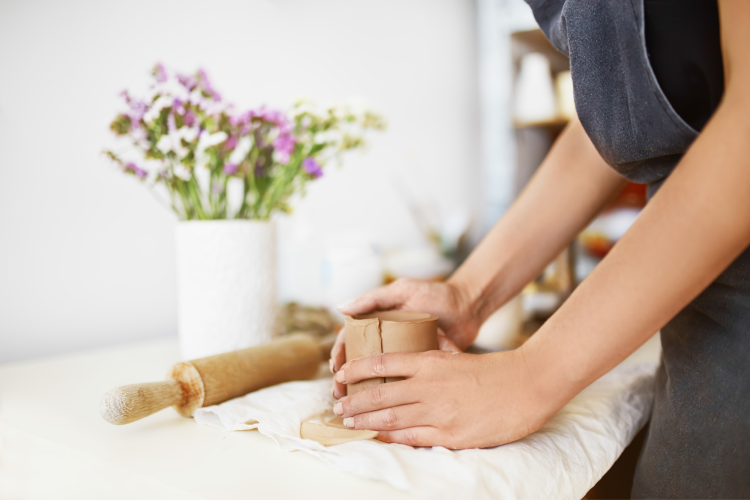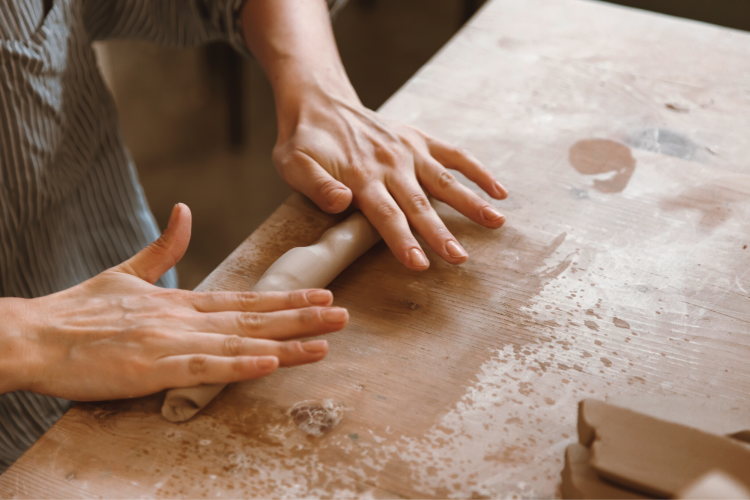Your Go-To Guide for Hand Building Pottery

Did you know that the hand building pottery method makes it easy to explore the art of pottery without having to rely on special or expensive equipment?
While we often think of wheel throwing to make pottery, artists have been crafting pottery from clay using only their hands and a few special tools for centuries. Now, you can, too! However, if you are hesistant to dive in head first, remember that creating art from clay has many benefits.
In fact, according to National Institutes of Health's National Library of Medicine, art making, including working with clay, has proven "relaxing, enjoyable, helpful for learning about new aspects of self, freeing from constraints" and more.
When it comes to pottery for beginners, most hand building techniques are fairly simple, but that doesn’t mean they can’t be used to create some unique and impressive pieces.
Whether you are a beginner looking to get started or an experienced artist ready to explore your creativity in new ways, our guide will break down everything you need to know about hand building pottery, including how to begin, information on different techniques and clay carving tools, and some hand building ceramic project ideas.
Jump to Section
- How to Start Hand Building Pottery
- Hand Building Pottery Techniques
- Hand Building Pottery Ideas
- Clay Carving Tools
How to Start Hand Building Pottery
If you’re feeling overwhelmed by the prospect of attempting pottery making on your own, then exploring pottery classes near you is a great place to start!
In these classes, experienced artists will guide you through hand building pottery, what pottery tools to use and other pottery techniques to help you create something beautiful. You'll get hands-on experience as you learn insights like the best types of clay for pottery, the difference between ceramics vs. pottery and other topics.
There are plenty of classes to choose from, and they all offer something a little different. Explore pottery classes in San Francisco, pottery classes in San Diego, pottery classes in Chicago or pottery classes near you to get started. And don't forget to create a unique signature like some of the most valuable pottery marks.

Hand Building Pottery Techniques
Molds
One technique for hand building with clay is to use molds to shape your pottery, such as a hump or slump mold. Regardless of the type of mold you use, the basic process is the same. To begin, roll out a slab of clay to your desired thickness, but make sure it’s an even thickness throughout.
Then, you’ll need to very carefully lift and drape your clay slab over the mold before pressing it down so it hugs the mold snugly. After cutting off excess clay from the edges and rim, you’ll want to smooth and tidy up the edges and any irregularities before letting it dry and adding the finishing touches.
Coil Method
For the coil method of hand building ceramics, you use the coil method for clay pot making, or for making bowls, vases and more. If you’ve ever rolled a clay worm or snake before (or maybe from Play-Doh), then you essentially already know how to make clay coils.
Once you’ve formed the clay into roughly quarter- to half-inch thick ropes, simply stack and build up the coils into your desired shape and texture, almost like stacking bricks.
Using either your fingers or tools, you can smooth the inside and outside of the clay, or leave the ribbed texture, depending on the look and feel you’re going for. This technique allows for a bit more flexibility than pinch pottery, especially since you can experiment with different ways of stacking and fusing together your coils.

Slab Method
The slab pottery method is one of the more advanced hand building pottery methods, where slabs of clay are joined together. Although this technique can be a bit trickier to master, it can create some of the most unique works of pottery.
When using this method, you’ll need to make sure that your clay is wet enough to make strong seams, but not so wet that it will collapse under its own weight once vertical.
Once you have the “walls” or “sides” for your desired shape, you need to score the clay (either with a wet finger or tool) by adding notched marks along the sides of the slabs that will be joined together.
Then, you can either brush on a slurry, glue-like clay, known as a “slip,” or place a sticky rolled piece of clay along the edge to join your slabs together. To add a bit of interesting texture to your pottery, you can place the flat slabs (while still wet) on canvas or another fabric to imprint the texture on the clay’s surface.
Pinch Pottery
Perhaps the simplest beginner hand built pottery idea, the pinch pot method involves pinching a single ball of clay into your desired shape. To make a pinch pot, press your thumb into the center of your clay ball, about halfway down to the bottom.
Then, gently rotate the sphere as you pinch the clay between your thumb and forefingers to hollow out the shape and create height. It’s a great way to get more comfortable working with clay before moving on to some more advanced techniques.
While beginner-friendly, this hand building clay idea can also be applied for more detailed projects, where you join together multiple smaller pinched pieces into something bigger.

Hand Building Pottery Ideas
Coffee Mug
One of the best beginner hand built pottery ideas is to make a coffee mug using either the pinch method or the coil method, or even a mix of the two. Plus, you’ll get to admire your artwork as you sip your favorite beverage every morning with this cute hand building clay idea!
Casserole Dish
When you’re up for a real hand building pottery project, a slab-built casserole dish is an excellent project to tackle. Constructing the vessel will require patience and precision, but the end result will be worth it when you have a stunning, handmade casserole dish make as a pottery gift or to serve up something delicious at your next dinner party.
Animal Sculpture
For a hand building pottery project that's cute and adorable, but also a bit more challenging than your basic pinch pot, try sculpting your favorite animal. This type of project will also let you practice some other hand building pottery skills, including scoring, slipping and coiling.

Clay Carving Tools
Function and Uses
While you don’t necessarily need any special tools when making pottery by hand, they can make certain tasks easier. For instance, potter’s needles are helpful for scoring slabs and coils, while fettling knives can be useful for trimming slabs or cutting across areas of your pottery to add texture or more detailed design.
Using clay carving tools when handmaking pottery can also help you achieve more detailed designs and shapes, and add finishing touches to your ceramic pieces.
Tools such as loop, wire and ribbon tools are delicate but excellent for hollowing out handmade pieces or adding extra details. Similarly, there are all sorts of wooden modeling tools that aid in adding more details to your pottery.
Pottery Sculpting Tools Set
If you’re looking to cover all your bases, it’s worth investing in a set of pottery sculpting tools. We’d recommend a 30-piece set or 40-piece set for hand building pottery.
Many of these sets include double-sided tools made from stainless steel and wood that are designed for carving, modeling, cutting, scraping, chipping, smoothing and more.

It’s time to grab some clay, embrace your creative side and start exploring the wonderful art of hand building pottery. Even if you’ve never made any sort of pottery before, you now have all the knowledge you need to get started with your first project, even if it’s just a simple pinch pot!
As you become more and more experienced, be sure to explore more advanced techniques and maybe even invest in some pottery sculpting tools to help bring your ceramic pieces to the next level of artistry. You can always return to this handy go-to guide for hand building pottery when you need additional guidance or inspiration.
For even more creative ideas and inspiration, check out other experiences happening on Classpop!

